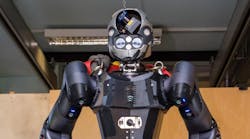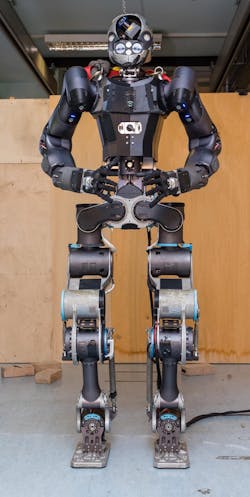The heart of the Istituto Italiano Di Tecnologia (IIT, Genoa, Italy) robotics strategy has always been the development of state-of-the-art mechatronics systems. This has led to the creation of internationally recognized humanoid robots and pioneering quadrupeds. IIT’s family of cutting-edge robots isn’t limited to legged systems, though. The Mechatronics program has explored completely new designs and operational paradigms, including materials, compliance, soft bodies, and distributed intelligence.
Besides its advanced integrated robot platforms, IIT researchers have developed component-level systems, including novel patented high-performance actuation systems, variable impedance actuators, advanced fingertip as well as large-area tactile sensors, exoskeletons (leg, arm, hand), instrumented haptic devices, novel medical systems, a variety of force/torque sensors, dexterous manipulators (e.g., SoftHand), and advanced industrial end-effectors.
The IIT Mechatronics program is developing new bodies for its integrated robotic systems, particularly for humanoid and legged robots. In these domains, researchers will focus on combining locomotion, manipulation, whole-body capabilities, new materials, and high-dynamics structures. As in most areas of engineering, it will be crucial to optimize energy use. To achieve this, they will use innovative lightweight and sustainable materials, improve mechatronics to better use the available power, and develop robots with more natural gaits and locomotion skills, coupled with enhanced actuator design.
Improvements in ruggedness, robustness, and reliability will require novel kinematics, shock-absorbing materials, and lightweight designs optimized for indoor and outdoor use in dirty and wet environments. They will develop highly integrated actuation solutions and decentralized diagnostics inspired by the new concept of “smart, high-performance mechatronics.”
Looking to the market, systems have been designed for prompt, affordable market applications. Here, the engineering goals require that they reduce mechanical complexity (fewer parts, no exposed wires, robust sensors), boost the payload-to-weight ratio, and improve the manipulation skills (dexterous hands, a wider range of movement in the shoulder and wrist). The reduced complexity will lower the cost of the robots, which is particularly important for the so-called companion robots. These systems will undergo extensive field-testing with end users, in line with the Technology Transfer Mission.
Delving Deeper into Locomotion
Advanced dynamical control and whole-body loco-manipulation are vital for complex human-like robots, particularly for locomotion and human-robot collaboration. In robot locomotion, where a flexible control strategy demands step recovery, walking, and running on possibly uneven terrains, advances will require the close integration of engineering (sensing, actuation, and mechanics), gait generation, dynamic modeling, and control.
The Mechatronics program will investigate locomotion, gait generation, and gait control in both bipeds and quadrupeds. With several robust platforms available, they will develop dynamic locomotion profiles. These will advance locomotion and loco-manipulation, particularly for operation in rough, hazardous, and poorly conditioned terrains, where wheeled and tracked vehicles cannot operate. The current locomotion capabilities on flat and moderately rough terrain will include very challenging environments (e.g., soft and unstable terrains).
The locomotion framework will reach higher levels of autonomy, allowing automatic selection of the most suitable gaits/behaviors for the environment. Combinations of machine-learning and optimization methods will be used to plan movements and control the robot.
With complex systems such as humanoids, it’s vital to achieve simultaneous manipulation and control, while maintaining operational parameters such as balance, walking, and reaching. This requires a new advanced approach to control. Torque regulation (through hardware and software) will be critical to success in this domain. IIT robots feature fully integrated torque sensing and controllers. In the near future, exciting developments in controller design will advance the functionality of these robots, and fill a crucial gap in humanoid technology.
IIT research in soft robotics will aim to produce soft, lightweight, sensitive structures, such as manipulators and grippers. They will exploit additive manufacturing technologies and customized sewing machines to generate 3D-fiber-reinforced structural composites that feature large deformation capacity, high load capacity, and variable stiffness. This approach may also influence the design of rigid robots by replacing rigid joints with soft, compliant joints or soft and elastic actuators (e.g., McKibben muscles).
IIT’s Soft Robotics program will focus on developing continuum robots (i.e., with similarities to the elephant trunk and cephalopod arms) that can grow, evolve, self-heal, and biodegrade. The goal is for these continuum robots to traverse confined spaces, manipulate objects, and reach difficult-to-access sites. Potential applications will be in medicine, space, inspection, and search-and-rescue missions. The Soft Robotics program will require an unprecedented multidisciplinary effort combining biology (e.g., study of plants), materials science (e.g., responsive polymer synthesis), engineering, and biomechanics.
Humanoid Robot
The Walk-MAN robot (Credit: IIT-Istituto Italiano di Tecnologia)
Researchers at IIT successfully tested their new version of a WALK-MAN humanoid robot for supporting emergency response teams in fire incidents (see figure). The robot is able to locate the fire position and walk toward it, and then activate an extinguisher to eliminate the fire. During the operation, it collects images and transmits these back to emergency teams, who can evaluate the situation and guide the robot remotely. The new WALK-MAN robot’s design consists of a lighter upper body and new hands, helping to reduce construction cost and improve performance.
During the final test, the robot WALK-MAN dealt with a scenario representing an industrial plant damaged by an earthquake that was experiencing gas leaks and fire—no doubt a dangerous situation for humans. The scenario was recreated in IIT laboratories, where the robot was able to navigate through a damaged room and perform four specific tasks: opening and traversing the door to enter the zone; locating the valve which controls the gas leakage and close it; removing debris on its path; and finally identifying the fire and activating a fire extinguisher.
The robot is controlled by a human operator through a virtual interface and a sensorized suit, which permits the robot to operate very naturally, effectively controlling its manipulation and locomotion, like an avatar. The operator guides the robot from a station located remotely from the accident site, receiving images and other information from the robot perception systems.
The first version WALK-MAN was released in 2015, but researchers wanted to introduce new materials and optimize design to reduce the fabrication cost and improve its performance. The new version of the WALK-MAN robot has a new lighter upper-body, whose realization took six months and involved a team of about 10 people coordinated by Nikolaos Tsagarakis, researcher at IIT.
The new WALK-MAN robot is a humanoid robot 1.85 meters tall, made of lightweight metal, like Ergal (60%), magnesium alloys (25%) and titanium, iron, and plastics. Researchers reduced its weight by 31 kilos—from the original 133 kilos to 102 kilos—to make the robot more dynamic. Therefore, legs can move faster due to having a lighter upper body mass to carry. The higher dynamic performance allows the robot to react faster with legs, which is very important to adapt its pace to rough terrain and variable interaction scenarios. The lighter upper-body also reduces its energy consumption; the WALK-MAN can operate with a smaller battery (1 kWh) for about two hours.
The lighter upper-body is made of magnesium alloys and composite structures, and is powered by a new version of lightweight soft actuators. Its performance has been improved, reaching a higher payload (10 kg/arm) than the original one (7 kg/arm). Thus, it can carry heavy objects around and sustain them for more than 10 minutes.
The new upper body is also more compact in size (62-cm shoulder width and 31-cm torso depth), giving to the robot greater flexibility to pass through standard doors and narrow passages.
The hands are a new version of SoftHand developed by Centro Ricerche E. Piaggio of the University of Pisa (a group led by Prof. A. Bicchi) in collaboration with IIT. They are lighter, thanks to the composite material used to construct fingers, and they have a better finger-to-palm size ratio (more human like) that allows WALK-MAN to grasp a variety of object shapes. Despite their weight reduction, hands keep the same strength as the original version, as well as their versatility in handling and physical robustness.
WALK-MAN body is controlled by 32 engines and control boards, four force and torque sensors at the hands and feet, and two accelerometers for controlling its balance. Its joints show elastic movement, allowing the robot to be compliant and have safe interactions with humans and the environment. Its software architecture is based on the XBotCore framework. The WALK-MAN head has cameras, 3D laser scanner, and microphone sensors. In the future, it can be also equipped with chemical sensors for detecting toxic agents.
The WALK-MAN robot was designed and implemented by IIT within the project WALK-MAN funded by the European Commission. The project started in 2013 and is now at its final validation phase. The project also involved the University of Pisa in Italy, the École Polytechnique Fédérale de Lausanne (EPFL) in Switzerland, the Karlsruhe Institute of Technology (KIT) in Germany, and the Université Catholique de Louvain (UCL) in Belgium. All partners contributed to different aspects of the robot realization: locomotion control, perception capability, affordances and motion planning, simulation tools, and manipulation control.
The validation scenario was defined in collaboration with the Italian civil protection body in Florence, which participated in the project as an advisor end-user.



